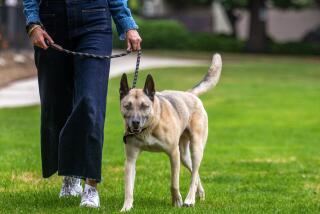How to Make an Animal Crackers : Crazy About Their Pets, People Turn Them Into Neurotics
- Share via
Once they roamed wild in packs, flesh-eating mammals clawing the earth to make a den, each knowing its place in the pecking order, leader to runt. Now they are pets, and in danger of being driven crazy by their owners.
Your precious dog may be showered with love and affection as if it were a member of the family or may be forced to languish alone in a fenced yard or a one-bedroom condo for eight hours a day.
Then, after an instinctual chomp on a chair leg or a reckless romp through the manicured flower bed, man’s best friend finds itself in the dog house.
People, experts say, can make their faithful companions crazy.
“Some people drive their pets neurotic,” said Hollywood veterinarian Peter Cyrog. “They don’t mean to, but they do.”
Environment-Induced
Sue Mylas, an animal behaviorist in Newport Beach, said 80% to 90% of all the mental problems in pets are caused by their environment.
“It’s simply because people are ignorant,” she said.
However, Peter Borchelt, an animal psychologist in Forest Hills, N.Y., said it’s a combination of the dog’s personality and the way it’s raised that can lead to a neurotic beast.
“Most dogs would become phobic by a thunderstorm if they encountered one,” he said. “But most dogs don’t encounter one.”
Nonetheless, a 1981 study by the University of Pennsylvania School of Veterinary Medicine found that 42% of 700 pet owners surveyed believed their dogs or cats--particularly attention-craving canines--had serious behavioral problems.
Richard Polsky, a renowned clinical animal psychologist in Culver City isn’t surprised.
They Have Their Reasons
Polsky, one of only about a dozen trained pet psychologists in the country, said isolation, confusion about its place in the household hierarchy, traumatic experiences early in life, and, worst of all, being treated like a human being can result in disturbing canine mental disorders.
After nearly 10 years of probing the animal psyche, Polsky recalled instances where the once playful puppy gradually turns into a people-biting, furniture-mauling, incessantly barking terror.
“There was the case of Sherlock, a 2-year-old basset hound who felt the bed was his and wouldn’t let the owner get in it,” Polsky remembered.
Naughty, Naughty Doggie
“And I treated one cocker spaniel who would poop in the living room and would refuse to let the owner clean it up. It would hide the stools.”
Polsky also recalled a spiteful little poodle who would pounce on his masters bed at night and urinate on him, a possible act of retaliation for being left alone so often.
Judith Creiner of Santa Monica said her pet beagle became so demanding that she had to compromise her life style.
“I had to take it everywhere,” she said. “I couldn’t go to a restaurant without bringing it along. It got to the point where I couldn’t even bring home a date without him going nuts.”
Polsky said a man who moved in with his girlfriend wanted her two Pomeranians to abandon their long-standing habit of nesting on the bed at night. The cuddle-conscious dogs, apparently jealous at the women’s new lover, would cry all night until allowed back in bed.
Mylas, founder of Companion Dogs of Newport Beach, a relationship school for humans and their pets, said she recently treated a dog so spoiled that it would bark only when its owners were on the telephone, feeling it was not being given enough attention.
Those jealous pangs and territorial imperatives also have been recorded in cats, though not often, veterinarian Cyrog said, adding that cats are much more independent and emotionally well-balanced than dogs.
“But I had one cat whose owner would play the piano and the cat loved it. But the cat attacked the piano tuner one day because it associated the piano with its owner,” Cyrog said.
A German shepherd recently came down with a colonic ulcer the size of a golf ball--the result, Polsky said, of a recently divorced woman’s lonely attempt to make the dog the indispensable joy of her life.
Immortalized Mutt
The woman had an oil painting of the dog mounted above the piano and kept photo albums of the creature, chronicling virtually every week of its life, Polsky said.
“It was amazing. She’d feed the dog from the table, take it to work. It even came into the bathroom with her,” he said. “So when she did have to leave her behind, the dog internalized it until it developed an ulcer.”
Generally speaking, cockers, springer spaniels, chow chows and German shepherds have a greater tendency to irritate their masters with unruly behavior, Polsky said.
On the other side of the canine ledger lies the more docile beagle, basset hound and schnauzer.
“Punishment,” Mylas said, “is the least effective tool in changing a dog’s behavior.”
Instead, “counter-conditioning,” according to animal psychologists and vets, is the preferred method these days. “You have to give them a reward such as food for not barking or for not tearing up the living room,” Polsky said.
“We try to teach ways that the dog knows the owner is the top dog in the house.”
Most important, Polsky continued, is to teach the dog to be independent by refusing to take it everywhere.
The two most common myths about raising a healthy canine, Polsky said, is waiting until the dog is 6 months old to train (it can be done when the dog is as young as 6 weeks) and that castration will make the pet less manageable. Castration actually has a tendency to mellow the dog, Polsky said.
More to Read
Sign up for Essential California
The most important California stories and recommendations in your inbox every morning.
You may occasionally receive promotional content from the Los Angeles Times.













